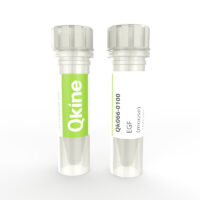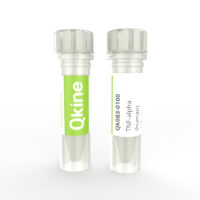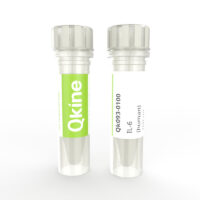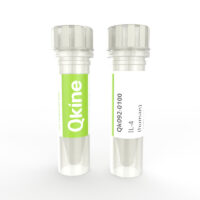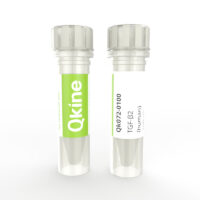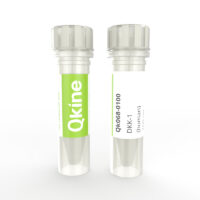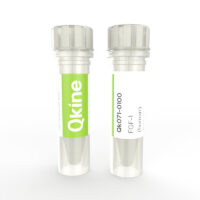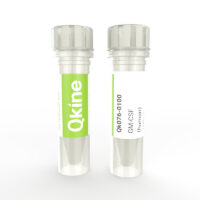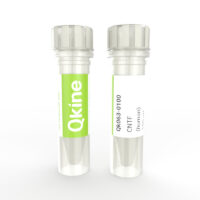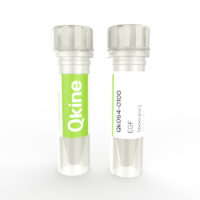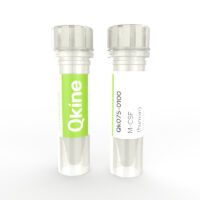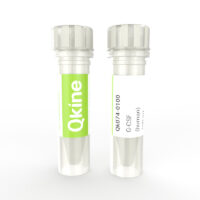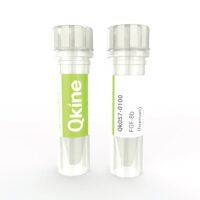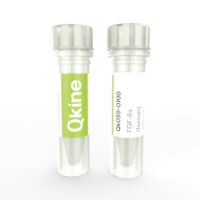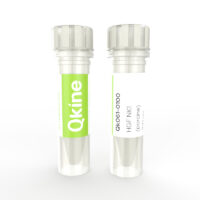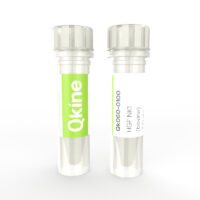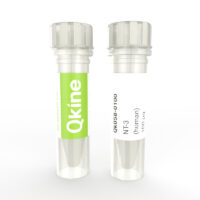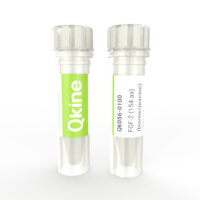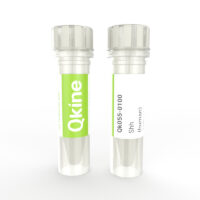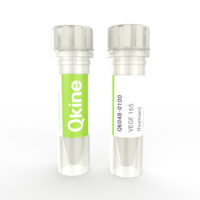- Epidermal growth factor (EGF), a member of the EGF family of proteins, plays a significant role in regulating cellular processes such as cell growth, proliferation, differentiation, development, and tissue homeostasis. It is an essential growth factor in many stem cells and organoid culture media.In cell culture, mouse EGF is crucial for stem cell maintenance, proliferation, differentiation, organoid culture growth and survival. It is also widely used for disease modelling, drug screening, tissue engineering, and regenerative medicine. Overall, EGF is a key player in cellular regulation and functions.Mouse EGF is a high purity protein with a molecular weight of 6.1 kDA. This protein is carrier-free and tag-free to ensure its purity with exceptional lot-to-lot consistency. Qkine mouse EGF is suitable for the culture of reproducible and high-quality stem cells and various tissue-specific organoids.
- Tumor necrosis factor-alpha (TNF-α) is a cytokine involved in cell signaling, primarily produced by immune cells like macrophages. It plays a central role in inflammation, immunity, and regulating cell survival and death. TNF-α binds to its receptors, TNF receptor 1 and TNF receptor 2, triggering pro-inflammatory responses, apoptosis, and immune cell activation.Human TNF-α has a molecular weight of 17.3 kDa. This protein is carrier-free and protein tag-free to ensure its purity with exceptional lot-to-lot consistency. Qk083 TNF-alpha is suitable for the culture of reproducible and high-quality hematopoietic stem cells and other relevant cells.
- Interleukin-6 (IL-6) is a multifunctional cytokine that regulates immune responses and inflammation. It is produced by various cells, including immune cells such as T cells and macrophages, as well as non-immune cells like fibroblasts and endothelial cells. IL-6 plays a critical role in infection defense and tissue damage by promoting inflammation and activating immune cells. IL-6 is involved in various physiological processes, including the regulation of metabolism, tissue repair, and hematopoiesis. Human IL-6 has a molecular weight of 20.9 kDa. This protein is carrier-free and tag-free to ensure its purity with exceptional lot-to-lot consistency. Interleukin-6 is suitable for the culture of reproducible and high-quality hematopoietic stem cells and other relevant cells.
- Interleukin-4 (IL-4) is a pleiotropic, immune-modulatory cytokine that is secreted primarily by mast cells, T-cells, eosinophils, and basophils. IL-4 plays a crucial role in hematopoiesis, the regulation of antibody production, the stimulation of activated B cell and T cell proliferation, and the differentiation of B cells into plasma cellsIL-4 induces the expression of class II MHC molecules on resting B-cells and aids regulation of the low-affinity Fc receptor for IgE (CD23) expression on lymphocytes and monocytes. IL-4 additionally is a key regulator in adaptive immunity.Human IL-4 has a molecular weight of 15.1 kDa. This protein is carrier-free and tag-free to ensure its purity with exceptional lot-to-lot consistency. Qk092 is suitable for the culture of reproducible and high-quality stem cells and other relevant cells.
- Transforming Growth Factor beta 2 (TGF-β2), part of the TGF-β superfamily, regulates a wide array of cellular processes, including proliferation, differentiation, wound healing, apoptosis, metabolism, embryogenesis, and tissue repair. It is an essential growth factor in many embryonic and induced pluripotent stem cell culture media.In cell culture, TGF-beta 2 is crucial for directing cell fate, especially in stem cells and differentiation and facilitating wound healing processes. As a modulator of immune responses and a factor in tumour development, TGF-β2's involvement extends to immunomodulation and interaction within the tumour microenvironment. Its other applications in cell culture include stimulating protein expression and secretion. Overall, TGF-beta 2 emerges as a key player in cellular regulation with diverse biological functions.TGF-beta 2 is a high purity protein with a molecular weight of 25.4 kDa. This protein is carrier-free and tag-free to ensure its purity with exceptional lot-to-lot consistency. Qkine TGF-beta 2 is suitable for the culture of reproducible and high-quality stem cells and other relevant cells.
- Dickkopf-related protein 1 (DKK-1) is a key player in the Wnt signaling pathway and regulates embryonic development, tissue balance, and diseases, including cancer. DKK-1 is a member of the DKK protein family and acts as a potent Wnt pathway antagonist.In cell culture, DKK1 is pivotal for controlling cell fate, self-renewal, and differentiation by inhibiting the canonical Wnt/β-catenin pathway through LRP5/6 co-receptors. DKK-1 has been widely used in various applications including guiding stem cell differentiation, particularly in neural and osteogenic pathways, and mimicking dysregulated Wnt signaling seen in cancers. Its inhibitory role is also crucial for anterior development.Human DKK-1 has a molecular weight of 25.7 kDa. This protein is carrier-free and tag-free to ensure its purity with exceptional lot-to-lot consistency. DKK1 is suitable for the culture of reproducible and high-quality stem cells and other relevant cells.
- Fibroblast Growth Factor 1 (FGF-1) regulates the proliferation, migration, and differentiation of mesenchymal cells, with roles in embryonic development, tissue regeneration, and wound healing. FGF-1 also has neurotrophic and lipid metabolism functions and can promote hematopoietic stem cell differentiation. It is implicated in tumor growth and migration.In vitro, FGF-1 can stimulate growth and differentiation of endothelial and epithelial cells and the development of organoids. FGF-1 can also be used for the maintenance of oligodendrocytes and astroglia as well as bone marrow-derived mesenchymal and hematopoietic stem cells.Human FGF-1 has a molecular weight of 15.9 kDa. This protein is carrier-free and tag-free to ensure its purity with exceptional lot-to-lot consistency. Qk071 is suitable for the culture of reproducible mesenchymal, endothelial, haematopoietic, glial, and other relevant cells.
- Granulocyte-macrophage colony-stimulating factor (GM-CSF) is a hematopoietic growth factor involved in the differentiation and activation of monocytes such as macrophages and dendritic cells, and granulocytes such as neutrophils, eosinophils, and basophils. It is also involved in the development of erythroid, megakaryocytes, and keratinocytes. GM-CSF binds to the GM-CSF receptor (CSF2R) and activates the JAK2/ STAT-5, Ras/ ERK, NF-kB, and PI3K pathways.It is commonly used in cell culture to stimulate the differentiation and maturation of human-induced pluripotent stem cells or peripheral blood monocytes to myeloid cells. GM-CSF can also increase the glycolytic activity of macrophages and promote an M1 polarization.Human GM-CSF is composed of 144 amino acids with a molecular weight of 14.6 kDa. This protein is animal-free, carrier protein-free, tag-free, and non-glycosylated to ensure a homogenous population with exceptional lot-to-lot consistency. Qk076 is suitable for reproducible and high-quality neutrophils and other relevant cell cultures.
- Ciliary Neurotrophic Factor (CNTF) is a member of the IL-6 family of cytokines. CNTF plays a crucial role in developing and maintaining the nervous system, in particular the optic nervous system. It promotes the maintenance, differentiation, and survival of various neurons, glial cells, and retinal cells.CNTF has been used in vitro to initiate neural induction and differentiation. CNTF can be used to culture primary neurons and glial cells such as astrocytes and Schwann cells. It is also used to culture retinal cells and adipocytes.Human CNTF has a molecular weight of 22.8 kDa. This protein is carrier-free, tag-free, and non-glycosylated to ensure its purity with exceptional lot-to-lot consistency. Qk063 is suitable for the culture of reproducible and high-quality neurons and other relevant cells.
- Porcine EGF is an essential growth factor belonging to the Epidermal Growth Factor family that stimulates the proliferation and differentiation of cells. It is used for the differentiation of induced pluripotent stem cells (iPSCs) and embryonic stem cells (ESCs) towards epithelial, neural, mesoderm and hematopoietic lineages. Porcine-EGF is becoming rapidly adopted as a species-specific growth factor in the cultivated meat sector. Porcine EGF is also an essential component of many organoid media supporting the culture and differentiation of a wide variety of organoids including intestine and liver organoids.Porcine EGF has a molecular weight of 6.3 kDA. This protein is animal-free, carrier protein-free, His-tag-free and non-glycosylated to ensure a pure recombinant protein with exceptional lot-to-lot consistency.
- Macrophage colony-stimulating factor (M-CSF) is a cytokine that regulates the survival, proliferation, differentiation, and functional activation of monocytes, such as macrophages and dendritic cells. Various cells produce and release M-CSF, such as endothelial cells, fibroblasts, osteoblasts, smooth muscle, and macrophages. M-CSF binds to the CSF-1 receptor (CSF-1R) leading to the activation of the PI3K-AKT and AMPK signaling.M-CSF has been used in vitro for the differentiation of human induced pluripotent stem cell (iPSC)-derived macrophages as well as the maintenance and development of monocytes in hematopoietic stem cell culture. M-CSF has also been used to influence macrophage polarization towards an anti-inflammatory or M2 macrophage phenotype.A highly bioactive, animal-origin-free (AOF), carrier protein-free 36.8 kDa recombinant protein with exceptional lot-to-lot consistency.
- Granulocyte colony-stimulating factor (G-CSF) is a member of the hematopoietic growth factor family which plays a crucial role in the proliferation, differentiation, and maturation of committed progenitor cells to granulocytes, such as neutrophils. G-CSF is produced by various cell types including macrophages, fibroblasts, and endothelial cells. It binds to the G-CSF surface receptors upon stimulation to activate key cellular processes involved in neutrophil proliferation, maturation, and mobilization in healthy and diseased states.G-CSF is commonly used in vitro to maintain neutrophils and stimulate the differentiation of cells to neutrophil lineage. is a highly pure, bioactive glycoprotein produced in an animal-free expression system composed of 174 amino acids with a molecular weight of 18.6 kDa. Human and murine G-CSF are 73% identical at the amino acid level and show species cross-reactivity. Human G-CSF is carrier-free, tag-free, and non-glycosylated to ensure a pure and homogenous production of high-quality neutrophils and other relevant cell cultures with exceptional lot-to-lot consistency.
- Fibroblast growth factor 8b (FGF-8b) is a member of the FGF family involved in the regulation of embryogenesis, cellular proliferation, differentiation, and migration.FGF8b is commonly used for the differentiation of induced pluripotent stem cells into neural cell types and brain organoid cultures.FGF8b is a spliced form of FGF8, a heparin-binding protein that targets mammary and non-mammary cells expressing the FGF receptors. A 22.5 kDa highly pure, bioactive recombinant protein produced in an animal-free expression system. This protein is carrier-free, tag-free and non-glycosylated to ensure a pure, homogenous protein with exceptional lot-to-lot consistency. Qk057 is suitable for enhanced reproducibility and physiologically relevant cultures.
- Fibroblast growth factor 8a (FGF-8a) is a member of the FGF family and plays a key role in the regulation of embryogenesis, cellular proliferation, differentiation, and migration. FGF8a is often used for the differentiation of induced pluripotent stem cells, embryonic stem cells, and neural stem cells.FGF8a is a spliced form of FGF8, a heparin-binding protein that targets mammary and non-mammary cells expressing the FGF receptors. A 21.3kDa highly pure, bioactive recombinant protein produced in an animal-free expression system. This protein is animal-origin free (AOF), carrier protein-free, tag-free, and non-glycosylated to ensure a pure homogenous protein with exceptional lot-to-lot consistency. Qk059 is suitable for enhanced reproducibility and physiologically relevant cultures.
- Recombinant porcine HGF protein is a potent, high-purity NK1 isoform of porcine hepatocyte growth factor (HGF). Porcine Recombinant Protein HGF differs from human HGF at several key amino acid residues that are predicted to affect bioactivity and receptor binding. Use of species-specific HGF growth factor will facilitate media optimization for cellular agriculture (cultivated meat) and veterinary applications. Also available is Qk060 Bovine HGF (NK1). The highly scalable animal-free manufacture and enhanced bioactivity make this suitable for chemically-defined media and reproducible scale-up.20kDa naturally occurring isoform of HGF, animal-free and carrier-protein free.
- Recombinant bovine HGF protein is a potent, high-purity NK1 isoform of bovine hepatocyte growth factor (HGF). Bovine HGF differs from human HGF at several key amino acid residues that are predicted to affect bioactivity and receptor binding. Use of species-specific HGF growth factor will facilitate media optimization for cellular agriculture (cultivated meat) and veterinary applications. Also available is Qk061 Porcine HGF (NK1). The highly scalable animal-free manufacture and enhanced bioactivity make this suitable for chemically-defined media and reproducible scale-up.20kDa naturally occurring isoform of HGF, animal-free and carrier-protein free.
- Neurotrophin 3 protein is part of the neurotrophin family and plays a crucial role in embryonic development and the maintenance and neuroprotection of the adult nervous system.NT-3 protein is used in cell culture to promote the differentiation and survival of specific neural subpopulations in both the central nervous system and peripheral nervous system such as sensory neurons, cortical neurons, and oligodendrocytes. It is also involved in the maintenance of endothelial cells and myocardial cells.Recombinant Neurotrophin 3 protein is a non-covalently linked homodimer with a molecular weight of 27.3 kDa.Qkine NT3 protein is animal-free (AOF), carrier-free, tag-free, and non-glycosylated to ensure its purity with exceptional lot-to-lot consistency. It is suitable for the culture of reproducible and high-quality cortical neurons and oligodendrocytes.
- Recombinant bovine/porcine FGF2 protein 154 aa (bFGF/basic FGF), this is the long form of FGF-2 used for the development of optimized serum-free culture media for species-specific bovine (cow) and porcine (pig) cultivated meat and veterinary research applications. Used in comparative media optimization studies with Qk040 porcine/bovine FGF-2 145 aa.FGF-2 is used extensively in the maintenance and proliferation of induced pluripotent (iPSC) and embryonic stem cells (ESC)1-3 and for enhancement of proliferation in primary cell culture.High purity 16 kDa FGF-2 / bFGF 154 aa protein, animal origin free (AOF) and carrier-protein free (CF).
- Sonic hedgehog protein (Shh) is a member of the Hedgehog family with an essential role in embryonic development, tissue regeneration, and tumorigenesis. Shh induces the cell fate and patterning of neural progenitors in ventral domains at various levels in the forebrain, midbrain, hindbrain, and spinal cord. It has many applications in the neural stem cell field where it plays a significant role in differentiating human-induced pluripotent stem cells (iPSC) towards motor neurons and interneurons. Also, it induces the patterning of organoids and embryos in culture.Recombinant Shh protein has a molecular weight of 19.8kDa. This protein is animal-free (AOF), carrier protein-free, and tag-free to ensure its purity with exceptional lot-to-lot consistency. Sonic hedgehog protein is suitable for the culture of reproducible and high-quality neurons and organoids.
- Recombinant human vascular endothelial growth factor 165 (also known as VEGF165/ VEGF-165/ VEGF-A/ VEGF165) protein is widely used in culturing primary endothelial cells, such as human umbilical vein endothelial cells.VEGF165 is commonly used with human-induced pluripotent stem cells or embryonic stem cells-derived endothelial cells for developing human vascular tissue models. It has many applications including its use in neural research involving oligodendrocyte precursor cells, Schwann cells, astrocytes, and microglia. It plays a role in bone formation, regulates mesenchymal stem cell differentiation, and serves as a survival factor for chondrocytes, hematopoietic stem cells, and tumor cells.Qkine recombinant human VEGF165 protein is a highly pure and potent 38 kDa homodimer, disulfide-linked consisting of two 165 amino acid polypeptide chains. It is an animal origin free (AOF) and carrier protein-free (CF) isoform of VEGF for high efficiency.
